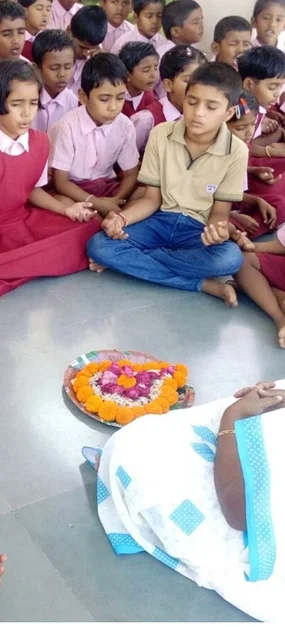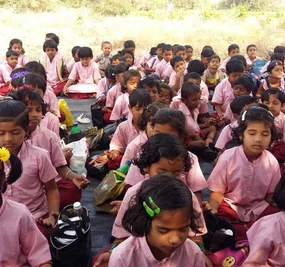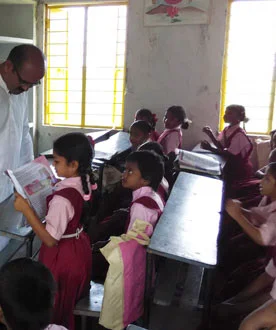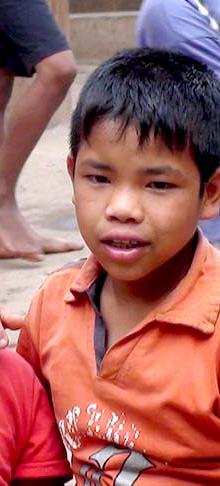This article is a part of the series on a free school run by the Art of Living volunteers in Guntur, Andhra Pradesh.
A small cold finger poked me awake, snapping me out of my woolly dreams on that chilly morning. I struggled to open my eyes to the first rays of the morning sun. Standing by my bed and grinning cheerfully was Vedanta. “Wake up, its 6, time for morning prayers”, he says and skips out as gaily as he had entered.
As I step out of my room into the open arena, I was awestruck by the majestic backdrop of the hills, where around 60 children happily lined up doing their Surya Namaskars. The smiles on their little faces belied the reality that these kids were abandoned, orphaned children, some of whom were picked by the police and handed over to the school. This was the Art of Living’s Sri Sri Seva Mandir school at Guntur.
The school shares our Founder, Gurudev Sri Sri Ravi Shankar’s, belief that education is incomplete unless it is well-rounded and holistic. Here classes are conducted not just within the confines of a closed classroom but also in the lap of nature, in the open grounds. The children take in nature as much as they focus on the goal of preparing for an academic future. It is thus not surprising to see students in the evenings indulging in organic farming, cooking, cleaning and taking care of the pets. Yoga, meditation, chanting, morning prayers are a part of morning daily routine for the school kids, and so is milking the cows!
Participation in these tasks starts from the age of seven, with each assigned responsibilities based on age and capacity. In other words, it involves blending with nature and being a natural part of it, rather than simply teaching the three R’s (reading, writing, and arithmetic). Additionally, dance, music, sports are an integral part of this education, with weekends especially devoted to celebration. It is not by chance that students who graduate from middle school and move on to other schools in the district shine to the point of drawing notice to their distinctive qualities and sharp minds. And shine they do, not among a small group of kids, but among a large group that can number in the thousands.
A story to be told
Each kid had a poignant story to tell before they were embraced by the love and care of Art of Living’s Sri Sri Gyan Mandir residential school.
For instance, the orphaned Vedanta, a child of HIV infected parents, was forced to fetch cigarettes, alcohol, and drugs by the older inmates of the shelter where he earlier lived. Not to mention, the offer of a share in the same, to force him into the same addiction. He was also taught to dismantle wheels of all kinds of vehicles which would later be sold.
Vedanta is not the only exception. There are plenty who hail from similar HIV infected abandoned families, parents lost to Naxal encounters, rescued from child marriages, or merely abandoned because of acute poverty.
However, that was Vedanta before the loving arms of Sri Sri Gyan Mandir hostel encircled him. Today, he is an entirely different child smiling through all that past.
“Not too long back, he spoke of an intense urge to break apart a wheel. We allowed him. But that was the last time a broken tire was attributed to him. Yet on another occasion, he disturbed a beehive by flinging a stone only to have them sting him mercilessly. With his swollen face he came up and asked me not to punish him further; stated that the stinging was punishment enough”, says Madam Maa with a smile, adding “we still have to make him view his dirt covered face in the mirror to persuade him to take that shower.”
But what you see now is a sensitive, humorous child who believes in living life to the full, in the right way, one who would be first to lend his hand to lift anyone, physically or emotionally.
Rebuilding lives
Not only have these children put their past behind and successfully rebuilt their lives, but they also have also begun reaching out to causes beyond the purview of the school campus. For instance, a 400-year-old Shiva temple in Guntur owes its restoration to these tiny yet strong arms and willing minds that strive to make a difference.
“The school took the project of restoring the temple, yet local help was needed to make the dream a reality. It was left to the children to convince their parents to be part of the initiative. What transpired was a powerful movement that culminated in the restoration of the temple and the ancient culture of the village”, says Maa.
What is the secret of this enormous transformation, an urge to make a difference?
It is the method of comprehensive education delivered from the ground up, targeting the most pitifully abandoned; orphaned youngsters and making a difference where it counts the most.
As Madam Maa concludes “It is the environment created in the school where they are taught to grow in harmony with nature, respecting it. The spiritual and practical education, social values and the extra-curricular activities contribute to overall growth. It is a holistic education to address the mind, body, and spirit, the way The Art of Living does best.”















